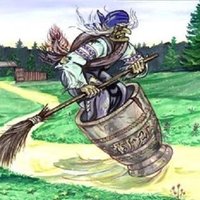
Baba Yaga
CBUB Wins: 1
CBUB Losses: 2
CBUB Ties: 0
Win Percentage: 33.33%
Added by: Dinsdale Piranha
Read more about Baba Yaga at: Wikipedia
Official Site: Public Domain
In Slavic folklore, Baba Yaga is a supernatural being (or one of a trio of sisters of the same name) who appears as a deformed and/or ferocious-looking woman. Baba Yaga flies around in a mortar, wields a pestle, and dwells deep in the forest in a hut usually described as standing on chicken legs. Baba Yaga may help or hinder those that encounter or seek her out and may play a maternal role and has associations with forest wildlife. According to Vladimir Propp's folktale morphology, Baba Yaga commonly appears as either a donor, villain, or may be altogether ambiguous.
Andreas Johns identifies Baba Yaga as "one of the most memorable and distinctive figures in eastern European folklore," and observes that she is "enigmatic" and often exhibits "striking ambiguity." Johns summarizes Baba Yaga as a "a many-faceted figure, capable of inspiring researchers to see her as a Cloud, Moon, Death, Winter, Snake, Bird, Pelican or Earth Goddess, totemic matriarchal ancestress, female initiator, phallic mother, or archetypal image".
Variations of the name Baba Yaga are found in the languages of the Eastern Slavic peoples. The first element, baba, is transparently a babble word. In Bulgarian and Serbian, "baba" ( "баба" ) means "Grandmother" or "an old woman". In Old Russian, the baba may mean 'midwife', 'sorceress', or 'fortune teller'. In modern Russian, the word babushka (meaning 'grandmother') derives from it, as does the word "babcia" (also 'grandmother') in Polish. Baba, diminutive of "babusia", means "Grandmother" in Ukrainian. In Croatian, Serbian and Polish languages "baba" means an old woman or sometimes just a woman. Baba may also have a pejorative connotation in modern Russian, both for women as well as for "an unmanly, timid, or characterless man". Similarly to other kinship terms in Slavic languages, baba may be employed outside of kinship, potentially as a result of taboo. For example, in variety of Slavic languages and dialects, the word baba may be applied to various animals, natural phenomena, and objects, such as types of mushrooms or a cake or pear. This function extends to various geographic features and, in the Polesia region of Ukraine, the plural baby may refer to an autumn funeral feast. These associations have led to variety of theories on the figure of Baba Yaga, though the presence of the element baba may have simply been taken as its primary meaning of 'grandmother' or 'old woman'. The element may additionally appear as a means of glossing the second element, iaga, with a familiar component. Additionally, baba may have also been applied as a means of distinguishing Baba Yaga from a male counterpart.
While a variety of etymologies have been proposed for the second element of the name, Yaga, it remains far more etymologically problematic and no clear consensus among scholars has resulted. For example, in the 19th century, Alexander Afanasyev proposed the derivation of Proto-Slavic *ož and Sanskrit ahi ('serpent, snake'). This etymology has subsequently been explored by other scholars in the 20th century.
Fantasy Teams Season 13 Record:
View the historical team line-up
| Result | Opponent | My Score | Their Score | |
|---|---|---|---|---|
| Loss | Buddy the Elf | 4 | to | 12 |
| Loss | Santa Claus (Nikamund) | 3 | to | 4 |
